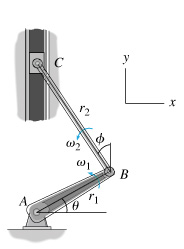Relative-Motion Analysis: Velocity
Learning Goal:
To
understand how to use the relative position and velocity equations to
find the linear and angular velocity of members in an assembly.

Part A - Relative Motion
The
relative velocity equation accounts for the general plane motion of a
point on a body. This general plane motion can be broken down into the
two primary components of motion, translation and rotation. For the
velocity equation,
vC=vB+vC/B
identify the correct translation and rotation components.
Part B - Velocity of B
Find the velocity of B , vB , when
θ=18.0∘
and
ϕ=7.05∘
. The crank is rotating at
300 rpm
(revolutions per minute). Express your answer in component form.
|
|
-5.82,17.9
|
|
Part C - Velocity of C
Find the magnitude of the velocity of C , vC , when the piston has moved to the new position
θ=30.0∘
and
ϕ=6.42∘
. The crankshaft (member AB ) is still rotating at
300 rpm
.
|
|
17.4
|
Part D - Rotational Speed of the Crankshaft
The velocity of the piston is
vC=70.0 in/s j
the instant when
θ=39.0∘
and
ϕ=5.76∘
. Find the rotational speed of the crankshaft (member AB ) at this instant. The crankshaft is rotating in the counterclockwise or positive direction.
(Figure 2)
|
|
1330
|
|
No comments:
Post a Comment